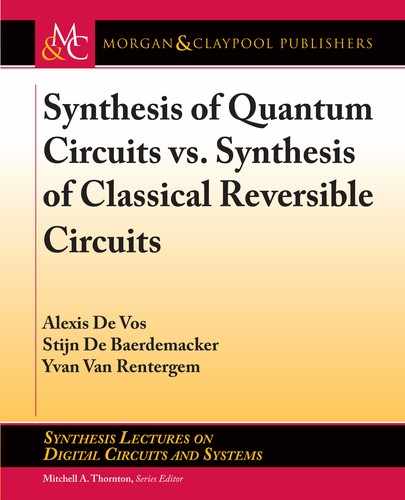
74 4. TOP
in the bXbZbX decomposition exactly matches the dimension n
2
of the matrix U . For n D 2
w
,
the schematic of the dual decomposition looks like
U
H
H
H
H
D
D
0
C
0
B
0
A
0
:
(4.10)
4.5 DETAILED PROCEDURE
Section 4.2 provides the outline for the primal synthesis of an arbitrary quantum circuit acting
on w qubits, given its unitary transformation (i.e., its 2
w
2
w
unitary matrix). However, the
synthesis procedure is only complete if, given the matrix U , we are able to actually compute
the four matrices A, B, C , and D. Fortunately, in contrast to the Idel–Wolf decomposition
(Section 3.7), the Führ–Rzeszotnik decomposition is analytically constructible.
e arbitrary member U of U(2) is given by (1.14). De Vos and De Baerdemacker noticed
two different decompositions of this matrix according to (3.6)-(3.7)-(3.8). Führ and Rzeszotnik
proved the generalization (4.3) for an arbitrary element
U D
U
11
U
12
U
21
U
22
of U(n), for even n values, by introducing the four n=2 n=2 matrix blocks U
11
, U
12
, U
21
, and
U
22
of U . ese four matrices usually are not unitary. Each has a polar decomposition:
U
jk
D P
jk
V
jk
;
where P
jk
is a positive semidefinite matrix and V
jk
is a unitary matrix. For details, see the
Appendix.
Just like there are two different expansions in the case n D 2, there also exist two decom-
positions in the case of arbitrary even n. We may choose either [62, 63]
A D .P
11
C i P
12
/V
11
B D .P
21
i P
22
/V
21
C D V
11
.P
11
i P
12
/
2
V
11
D D i V
11
V
12
(4.11)
or [63]
A D .P
11
i P
12
/V
11
B D .P
21
C i P
22
/V
21
C D V
11
.P
11
C i P
12
/
2
V
11
D D i V
11
V
12
: (4.12)
..................Content has been hidden....................
You can't read the all page of ebook, please click here login for view all page.
